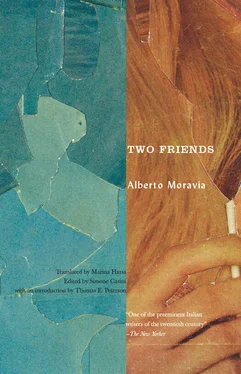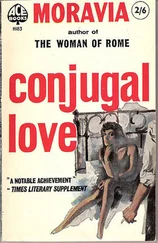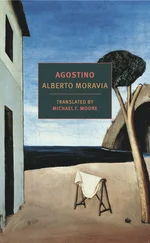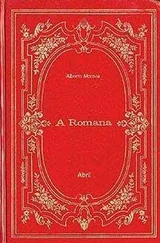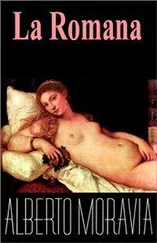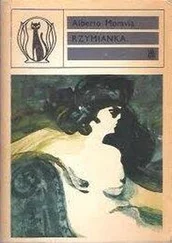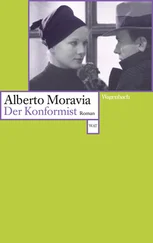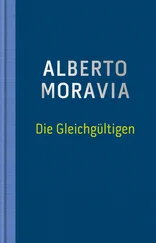3) Two letters intermixed with the pages of Version B probably reflect the accumulation of papers on Moravia’s desk (pages 75 and 112). Page 75 contains an invitation to an exhibition, written on letterhead from the Centro Nazionale di Studi Umanistici di Roma and dated May 15, 1952. Page 112 is a typewritten letter dated May 16, 1952, and addressed to “Riccio,” probably Attilio Riccio. In the letter Moravia discusses the contract for a screenplay (perhaps the one that appears on page 96).
4) Two pages (67 and 69) belong to Version C but are mixed in with the pages from Version B. This too is an important clue, because the intentional placement of these two pages among the pages of the second draft confirms the chronological precedence of Version B (written in the third person) with respect to Version C (written in the first person). In Version C, Moravia returns to characters and situations from Version B (such as the arrival at Maurizio’s villa on page 68 and the description of Maurizio on page 70), but he leaves pages 67 and 69 unfinished, mixed in with the pages of Version B, and decides to write them again. The new pages are placed in Version C (273 and 272*). (To avoid confusion, the pages from Dossier 4 are indicated with an asterisk; the pages without this symbol are all from Dossier 6.)
It appears that the typescript of Version B may date from the period April — May of 1952 and was subsequently used as a draft for Version C.
VERSION C
The third draft, which we have called C, consists of eighty-two pages, plus twenty-two additional pages abandoned or rewritten at this stage of composition. These are clusters of unordered pages whose narrative continuity can be easily reconstructed: pages 226–29, 230, 238–41, and 242–96 from Dossier 6 and pages 260*–74*, 238*, 237*. 236*, 235*. and 234* from Dossier 4. There are only a few corrections, written in pen on (pages 229, 255, 293, and 273*). Pages 144, 148–60, and 217*–33* were all discarded by the author. There are no page numbers or other notes.
There are very few clues to the dates of composition. The draft includes pages from another typescript (pages 145–47), that of the Roman tale “Il pensatore” (“The Thinker”), which was published in the Corriere della sera on May 4, 1962. But it is impossible to pinpoint the moment at which the pages were mixed together. However, since Version C was written after Version B and before Moravia began work on Il disprezzo ( Contempt ), as we will discuss, the composition of this version can be dated sometime between May and July 1952.
A few breaks in the text, which we have preserved, indicate breaks in the narration, some of which were probably temporary. The breaks are indicated with blank space or typed symbols and occur on typescript pages 229, 240, 249, 259, and 268*. Page 259 suggests a continuation, after the final line, “I would have liked to s.” Thus, it is possible to theorize the following sequence, in six chapters:
I. (pp. 226–29): the “first important event”: Sergio’s inscription into the Communist Party
II. (pp. 230, 238–40): the “second important event”: the encounter with Nella
III. (pp. 241–49): life with Nella
IV. (pp. 249–59): the encounter with Maurizio
V. (pp. 260–96 and 260*–68*): the party at Maurizio’s house
VI. (pp. 268*–74*, 238*. 237*. 236*. 235*, and 234*): Sergio’s conversation with Maurizio
Again, this is only a provisional breakdown. If we consider the structure of Moravia’s novels from this period, we can imagine that the author intended to include a prologue, distinguishable as such from the start, in which the narrator would illustrate the “two important events” in his life during the period after the end of the war; in other words, Sergio’s inscription into the Communist Party and his encounter with Nella. This would be followed by the first real narrative event; in other words, the “first chapter,” in which Sergio describes Maurizio’s invitation and the party.
The composition of Version C evolved in two phases, as suggested by the change in the name of the female character, from “Lalla” (as in the previous version) to “Nella.” Her characterization is profoundly different in each phase. As we will see, we are talking about an important rethinking of the character. This new version introduces, for the first time, the theme of “contempt” which will eventually lead to the abandonment of this project and the starting point of a new novel. For reasons of clarity, we will refer to phases C1 and C2.
The draft of C1 proceeds, without interruption, for about ten pages (226–29, 158–60, and 242–44). Lalla is self-assured, “rough,” provocative. But beginning on page 245, she becomes Nella, and is characterized by her timidity and gentleness. In this context, Moravia rewrites the pages describing their first meeting in the offices of the Allied Services, but does not bother to rewrite the pages that precede or follow this scene. He replaces pages 158–60 of C1 with pages 230 and 238–41 of C2. He hastily ties the the new pages together with the previous pages, crossing out (with a pen) the sections of page 229 in which the young woman first appears under the name “Lalla.” But he does not bother to do this on following pages. This creates a confusing deformation of the text, caused by a lack of agreement between pages 241 (C2) and 242 (C1). The sequence and the author’s intentions are clear, but it seems that a revision parallel to the one on page 229 never took place.
In accordance with our decision to publish the text in its most advanced form, we have adopted phase C2, while including the corresponding pages from C1 in the appendix. In addition, we have made a few indispensible changes in order to connect pages 241 and 242. To begin with, we eliminated the first seven lines of page 242 (which appear in the appendix), just as the author did on page 229. As we have already observed, in this phase of composition, Moravia was not overly concerned with eliminating earlier versions but was careful to distinguish between abandoned versions and more recent ones. Once again we can theorize that the author was simply saving time and was planning to correct the draft in a later revision. Secondly, we changed the name “Lalla” to “Nella” in the three pages from C1 preserved with C2 (242–44). Despite these small edits, there are a few spots in which these pages refer to elements that have been either cut or altered. For example, the beginning of page 243 (“I said earlier that this was a difficult period in my life but in truth it was probably the happiest time I had known”) refers to a phrase that the reader will not find in the text but rather in the version that appears in the appendix. The same is true of the reference to the “radio service” (page 243), rather than to a generic office of the Allied Services, which refers back to one of the abandoned pages. Nella’s “clumsiness,” to which Sergio refers on page 243, is also a leftover from the character of Lalla.
In C2, as we have indicated, the theme of “contempt” is developed for the first time (page 240). It is mentioned only in passing in C1 (page 160). The importance of the appearance of this theme is clear in Moravia’s process — this is the point at which the author probably decided to abandon the project at hand, which was centered on the ideological rivalry between two friends, and to instead proceed with a different novel, which would eventually be titled Il disprezzo ( Contempt ). Thus, the development of Il disprezzo can be said to have begun in July 1952, at the moment the current project was abandoned. We should keep in mind that the feelings of contempt described by the narrator Sergio are quite different from the contempt which provides the subject of the subsequent, eponymous novel. In fact, the original title of the latter novel was Il fantasma di mezzogiorno ( A Ghost at Noon ). One significant difference: in the earlier novel, the feeling is experienced by the narrator toward the woman whom he is using as a means to an end, while in the later book, published in 1954, the feeling is experienced by the woman toward her husband.
Читать дальше
